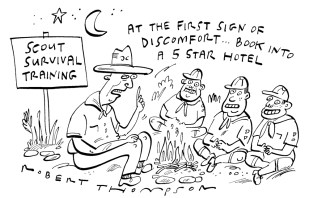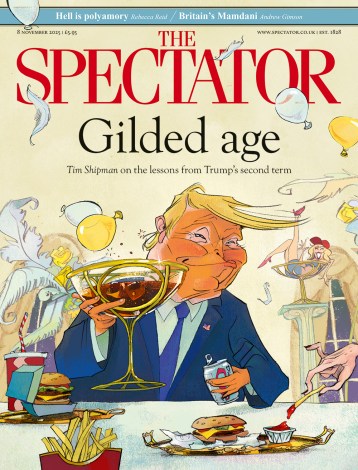Russian politicians often refer to something called the Dulles Plan. This document purports to capture the future CIA chief Allen Dulles explaining, in 1948, the US strategy to destroy the moral foundations of the USSR and bring about ‘the death of the most intractable people on Earth… the definitive, irreversible dying out of its self-consciousness’. If this sounds like a fictional villain’s expository monologue then that’s because it is. The text was taken from an antagonist’s speech in a 1971 novel, Eternal Call, which itself recalled a much earlier Russian forgery, the anti-Semitic Protocols of the Elders of Zion. The ‘plan’ was written and disseminated in 1993 in an attempt to explain the collapse of the communist system, but its debunking has not prevented it being invoked to justify such ‘defensive’ measures as the invasion of Ukraine.
The Moscow-born Victor Louis thrived as a journalist on ‘scoops’ provided by Soviet intelligence
The dissemination of fantastical plots in phoney documents is a legacy of the KGB. Though the agency was dissolved in 1991 its methods endure under Vladimir Putin, who served it for 16 years. Phrases such as ‘fake news’ and ‘post-truth’ may feel new, but, as Mark Hollingsworth explains, the KGB was dedicated to creating ‘a climate of chaos, fear and pervasive uncertainty in which nobody could be trusted’.
Hollingsworth’s subjects are not John le Carré spies, with missions and handlers, but ‘agents of influence’ who operated in a more informal, deniable fashion to shape policy and spread disinformation: what the KGB designated ‘active measures’. A 1964 Foreign Office report argued that such an agent ‘may be even more dangerous than a spy who is selling military secrets’. The thrillerish shadow world of spooks and honeytraps sometimes distracts Hollingsworth from his own premise (a couple of chapters are nothing more than Cold War yarns), but when he’s on track he spices familiar tales with new tidbits from government archives and interviews in order to emphasise the continuity between the KGB and Putin’s FSB.

In one form or another, the Russian secret police is as old as the tsars, from Ivan the Terrible’s murderous, black-clad Oprichniki through to the Okhrana under Nicholas II. Their dirty job was taken up with relish after 1917 by Lenin’s Cheka, which mutated into the OGPU, the NKVD, the MGB and, in 1954, the KGB. These agencies were lionised by the state – ‘every Bolshevist should make himself a Chekist,’ said Lenin – and by popular culture. Putin once said of his first attempt, aged 16, to join up in 1960s Leningrad: ‘My notion of the KGB came from romantic spy stories.’
The KGB’s allure extended to many in the West. Some agents were ardent communists but many were driven by a less principled combination of greed, vanity, spite and thrill-seeking. Recruits included a few politicians, such as the Labour MP Bob Edwards, and numerous journalists. At one point in the 1970s, according to the KGB defector Stanislav Levchenko, ten out of 12 foreign correspondents for the Japanese newspaper New Times worked for him.
Some star assets enjoyed illustrious careers. In 1949, George Orwell correctly identified the Times correspondent Peter Smollett OBE as ‘almost certainly an agent of some kind’, but the full story of his collaboration with the spies Kim Philby and Guy Burgess while working for Churchill’s Ministry of Information would not emerge until after Smollett’s death in 1980. Meanwhile, the Moscow-born Victor Louis thrived as a journalist on ‘scoops’ provided by Soviet intelligence. A 1981 Foreign Office report described the job of ‘Louis the Leak’ as ‘to sow confusion, plant lies, peddle fraudulent or stolen manuscripts and smear the reputations of dissenting Soviet intellectuals’.
The KGB became the world’s most industrious conspiracy-theory factory, forging documents and placing false stories in sympathetic newspapers and journals. Quantity trumped quality: if one story didn’t stick there was always another. Agents were cavalier about the consequences of this epistemic chaos. Operation Denver, the lie that Aids originated in a US biowarfare laboratory as a means to kill black and gay people, was simply another dart to throw at America in the 1980s, but it outlived the USSR and contributed to setting back Aids prevention, especially in South Africa, leading to hundreds of thousands of unnecessary deaths.
By contrast, most of the KGB’s targeted attempts at smears, blackmail and election subversion were damp squibs. Sometimes they even fell for their own fictions. Shortly before he became Soviet leader in 1982, the KGB chief Yuri Andropov launched Operation RYAN, a massive effort to ‘prove’ that Ronald Reagan and Margaret Thatcher were plotting an imminent nuclear strike, and believed it himself before ruefully admitting that he had ‘considerably exaggerated their aggressiveness all along’. As Putin likewise demonstrates, the architects of paranoia often become its victims.
The hole in Hollingsworth’s entertaining story is the reason why so many KGB fabrications seemed plausible. He only fleetingly acknowledges that when KGB forgeries accused the CIA of ‘organising a coup, infringing on sovereignty and abusing human rights’, they were elaborating on proven skulduggery. The point is not that both sides were equally bad but that Soviet disinformation grew in fertile soil: if the CIA had done this, then why not that? The KGB was also adept at exploiting the West’s homegrown conspiracy theories. Wild claims about the origins of Aids were circulating in the US before the Soviets weaponised them. Effective disinformation agents are opportunists.
The Russian word vranyo describes a species of lie that Hollingsworth defines as a brazen indifference to the truth, scorning the notion that one can identify it, or that it matters. This, more than espionage, is the FSB’s modus operandi – the lesson it learned from the KGB’s hits and misses. It is not just the internet that has made this job easier. During the Cold War, the US and the USSR were radically different societies; but Donald Trump’s Republican party, with its intense distrust of science, the media and government institutions and its extraordinary appetite for magical thinking is in the vranyo business. Today’s FSB agent, bent on spreading disinformation and destabilising western democracies, has the wind at his back.






Comments